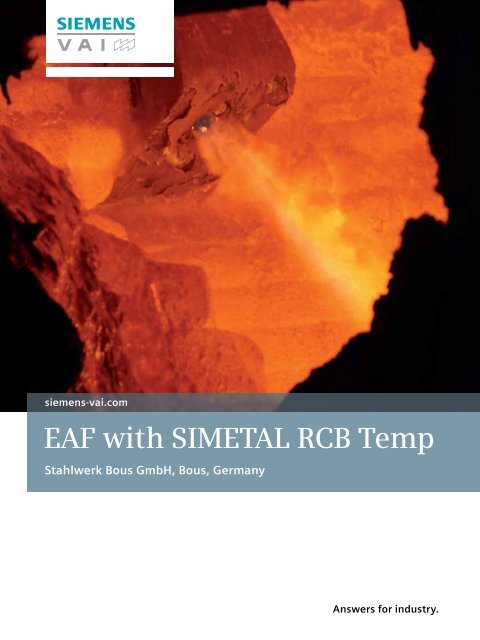EAF with SIMETAL RCB Temp
EAF with SIMETAL RCB Temp
EAF with SIMETAL RCB Temp
Create successful ePaper yourself
Turn your PDF publications into a flip-book with our unique Google optimized e-Paper software.
siemens-vai.com<br />
<strong>EAF</strong> <strong>with</strong> <strong>SIMETAL</strong> <strong>RCB</strong> <strong>Temp</strong><br />
Stahlwerk Bous GmbH, Bous, Germany<br />
Answers for industry.
Contact-free temperature measurement<br />
Innovation in temperature measurement<br />
Your challenge:<br />
Optimal steel production depends to a great extent on<br />
temperature control – that‘s why the precise and reliable<br />
measurement of temperature is essential. Typically, manual<br />
operations or manipulators are involved in temperature<br />
measurement by taking samples <strong>with</strong> conventional sensors<br />
to determine the tapping temperature. However, for efficient<br />
process control it is desirable to shorten the time between<br />
measurements during power-on before the tapping<br />
temperature is reached.<br />
Benefits:<br />
• Safety improvement<br />
• Increased productivity<br />
• Less temperature cartridges<br />
• Reduction of personnel cost<br />
• Considerable time and energy savings<br />
• No personnel risks during measuring<br />
as the slag door is closed<br />
• Faster temperature measurements<br />
• Short amortisation time<br />
Our solutions:<br />
<strong>SIMETAL</strong> <strong>RCB</strong> <strong>Temp</strong> uses a supersonic oxygen injection<br />
technology combined <strong>with</strong> analyzing and control units for<br />
contact-free temperature measurement. The units allow<br />
the temperature of liquid steel to be measured inside the<br />
furnace <strong>with</strong> doors closed, and offer major advantages<br />
over existing technologies. The results are far more accurate,<br />
<strong>with</strong> fewer unstable measurements, and allow monitoring<br />
of the steel temperature until the target tapping temperature<br />
is reached.<br />
<strong>SIMETAL</strong> <strong>RCB</strong> <strong>Temp</strong> brings you one step closer to fully<br />
automatic steelmaking under safe and reliable operating<br />
conditions.<br />
It eliminates the need for cost-intensive cartridges for<br />
temperature measurement.<br />
Scope of supply:<br />
• Valvestand for Nitrogen<br />
• <strong>RCB</strong> <strong>Temp</strong> Lance <strong>with</strong> quick coupling<br />
• <strong>RCB</strong> <strong>Temp</strong> Analyser Unit<br />
• <strong>RCB</strong> <strong>Temp</strong> Controller<br />
• Large <strong>Temp</strong>. Display<br />
• HMI integration
Operational principle<br />
<strong>SIMETAL</strong> <strong>RCB</strong> <strong>Temp</strong> consists of a burner <strong>with</strong> an integrated<br />
oxygen lance. The lance injects oxygen <strong>with</strong> a supersonic<br />
laminar jet at a special angle. To protect the central<br />
laminar oxygen stream, the burner shrouding function<br />
is maintained during the refining process. Switching<br />
<strong>SIMETAL</strong> <strong>RCB</strong> <strong>Temp</strong> from lance to temperature mode<br />
allows contact-free temperature measurements.<br />
Functions<br />
The customer<br />
Name:<br />
Stahlwerk Bous GmbH<br />
Location:<br />
Bous, Germany<br />
Services:<br />
Stahlwerk Bous GmbH currently<br />
manufactures around 800 steel grades<br />
<strong>with</strong> chrome contents of up to 16% and<br />
nickel contents of up to 4%. Steel from<br />
Stahlwerk Bous GmbH is distinctive on<br />
account of its impressively high degree<br />
of purity as well as the fact that it is<br />
available in a wide variety of formats<br />
as both ingot and continuous casting<br />
<strong>SIMETAL</strong> <strong>RCB</strong> <strong>Temp</strong> is characterized by three main functions:<br />
burner mode, lance mode and temperature mode.<br />
1. Burner mode<br />
During power-on times, <strong>SIMETAL</strong> <strong>RCB</strong> <strong>Temp</strong> can be used<br />
as a burner to preheat the scrap using various power<br />
settings depending on the type of scrap and volume of<br />
the furnace.<br />
2. Lance mode<br />
As soon as the scrap is heated to the point where a<br />
reaction occurs between carbon, iron and oxygen, the<br />
system switches to lance mode to provide a supersonic<br />
oxygen Stream<br />
3. <strong>Temp</strong>erature mode<br />
<strong>Temp</strong>erature measurement begins when a defined level<br />
of Homogenization of the liquid phase occurs. The system<br />
switches from lance mode to temperature mode and the<br />
temperature signal is transmitted.
Headquarters:<br />
Siemens VAI<br />
Metals Technologies GmbH<br />
P.O. Box 4, Turmstr. 44<br />
4031 Linz, Austria<br />
Phone: +43 732 6592 76809<br />
E-mail: contact.metals@siemens.com<br />
siemens-vai.com<br />
Order No. E10001-M3-A282-V1-7600<br />
Dispo No.: 21661 K-No.: 28103 | Printed in Austria | SVAI<br />
GB 120936 | © 12.2012, Siemens AG<br />
The information provided in this brochure contains merely general<br />
descriptions or characteristics of performance which in actual case<br />
of use do not always apply as described or which may change as<br />
a result of further development of the products. An obligation to<br />
provide the respective characteristics shall only exist if expressly<br />
agreed in the terms of contract.<br />
All rights reserved. Subject to change <strong>with</strong>out prior notice.<br />
printed climateneutrally<br />
Certifi cate Number:<br />
006-53612-0411-1001<br />
www.climatepartner.com


